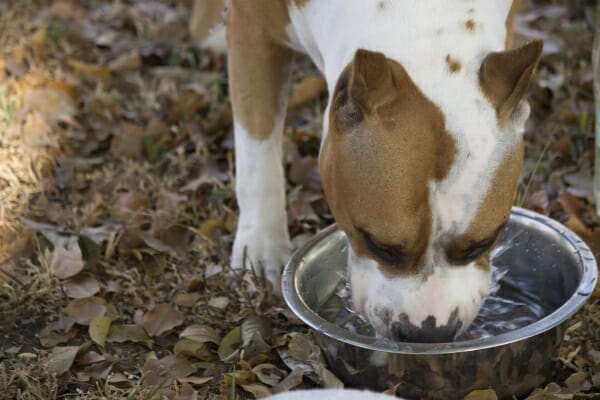If your dog gets into chocolate, you may wonder, “How much chocolate can kill a dog?” and “Do I need to head to the vet?” Integrative veterinarian Dr. Julie Buzby helps answer those questions by discussing why chocolate is poisonous for dogs, guidelines for determining toxicity, and what to expect should you need to bring your dog to the vet for treatment.

If your dog has ever snuck into your food pantry or a child’s trick-or-treat bag to scarf down some chocolate, it may have felt like hitting the jackpot to him or her. However, the only thing your dog may have won is an upset stomach (or worse) and a trip to the vet. Plus, a worried mom or dad who knows that chocolate is poisonous to dogs.
No dog owner likes having to bring his or her dog in to be seen at the vet on an emergency basis. Especially when those emergencies occur at two or three o’clock in the morning or right around a holiday. However, understanding a bit more about chocolate toxicity may help ease your mind some. Plus, knowing what information to give to the vet can aid your dog’s treatment.
Why is chocolate bad for dogs?
It may or may not surprise you to learn that chocolate is actually plant-based. (Further proof that it must be good for you, right?) Chocolate comes from cacao trees which grow in temperate climates. Cacao pods are the fruit of these trees. Inside the pod is a bitter seed which is hulled and ground down to leave behind a liquid called chocolate liquor.
The chemicals present in chocolate liquor are what make chocolate toxic to dogs. Chocolate contains caffeine and theobromine, which are compounds known as methylxanthines. The concentration of these compounds depends on the type of chocolate—the darker the chocolate, the more liquor is present. Methylxanthines are also present in drinks like coffee and tea, and herbal medications like guarana.
Which types of chocolate are most toxic?
Different types of chocolate contain different amounts of chocolate liquor. This is what accounts for the differing toxicity levels. It is also why it is important to know not just that your dog ate chocolate, but also what kind of chocolate and how much.

Since it is the darkest chocolate (and therefore contains the most chocolate liquor), baker’s chocolate tends to be the most toxic. It is followed by semisweet chocolate. Next come milk chocolate and chocolate-flavored cookies or cakes. While they are less toxic, they still contain enough methylxanthines to be problematic. Last on the list is white chocolate. While it is the least likely to cause illness, the answer to “Can dogs eat white chocolate?” is still “no.”
The chart below gives the methylxanthine concentration in milligrams/ounce (mg/oz) for the different chocolate types:
| TYPE OF CHOCOLATE | MG/OZ OF METHYLXANTHINES |
| Cacao beans | 300-1500 |
| Cocoa powder (unsweetened) | 800 |
| Baking chocolate (unsweetened dark chocolate) | 400 |
| Semisweet chocolate | 150 |
| Milk chocolate | 64 |
| White chocolate | < 1 |
As an important side note, some cocoa bean mulch also contains methylxanthines. Depending on the processing method, it may contain up to 255 mg/oz of methylxanthines. Please be cautious when using cocoa bean mulch as it could also be toxic if your dog decides to snack on some while outside.
How much chocolate can kill a dog?
If you catch your dog eating chocolate, you will need to keep a few things in mind (while trying not to panic). In order to determine how harmful the chocolate could potentially be, you will need to know the following pieces of information:
- Your dog’s weight (in pounds or kilograms)
- The type of chocolate consumed
- The amount of chocolate ingested
This is the same information you should provide your vet when you talk to him or her or bring your dog to the clinic.

Chocolate toxicity is calculated based on the amount of methylxanthines per unit of body weight. This means that your dog’s body weight will impact how poisonous his or her exposure might have been. For example, smaller dogs may be more susceptible to problems from eating an ounce of milk chocolate. However, big dogs would need to consume larger amounts of milk chocolate for there to be any issues.
Because methylxanthine concentrations can vary among types of chocolate, you will also need to find out what kind of chocolate your dog ingested. Sometimes the packaging gives you a good idea of the chocolate type. However, it isn’t always very clear. If you’re not sure, Google can be helpful with this step. While it might be difficult to figure out in some cases, this step is important. Just a couple of ounces of baking chocolate can be far more dangerous than the same amount of a milk chocolate bar.
Also, do your best to estimate how much chocolate you think your dog consumed. Sometimes this can be challenging because dogs may eat the wrapper along with the chocolate. It is also harder with products that aren’t pure chocolate, such as cookies or candy.
Chocolate toxicity chart
The basic formula for calculating the milligrams(mg) of methylxanthines per pound (lb) or kilogram(kg) is : [amount of chocolate (in oz) x methylxanthine concentration of that chocolate type (in mg/oz)] / body weight (in lbs or kgs)
The chart below shows what you can expect at different levels of methylxanthine consumption on a milligram per pound of body weight (mg/lb) or milligram per kilogram of body weight (mg/kg) basis:
| METHYLXANTHINE CONSUPTION | POSSIBLE SIDE EFFECTS |
| <9 mg/lb (<20 mg/kg) | Significant signs are unlikely |
| 9-18 mg/lb (20-40 mg/kg) | Mild to moderate clinical signs: vomiting, diarrhea, restlessness |
| 18-23 mg/lb (40-50 mg/kg) | Severe clinical signs: agitation, rapid heart rate, high blood pressure, elevated body temperature, unsteady gait, hyperactivity, rapid breathing, increased urination |
| < 27-36 mg/lb (>60-80 mg/kg) | Seizures, tremors, coma |
| 45-90 mg/lb (100-200 mg/kg) | Possible death |

Chocolate toxicity calculator
To make it a little easier to figure out if your dog ate a dangerous amount of chocolate, you can also take advantage one of the many dog chocolate toxicity calculators available online. The Merck Veterinary Manual provides a great chocolate toxicity calculator. You plug in your dog’s weight, type of chocolate, and amount of chocolate. Then the calculator tells you how many milligrams of methylxanthine your dog has consumed and if emergency treatment is recommended.
DISCLAIMER: The chocolate toxicity calculator and the chart above are meant to give you a general idea of what to expect and how to proceed. However, they are not intended to be a substitute for professional veterinary advice. If you suspect your dog has ingested chocolate or another potential toxin, please call your veterinarian or Animal Poison Control immediately.
Some dogs may be more sensitive to the effects of methylxanthines or have underlying medical issues that put them at risk for more significant effects. It is also possible that your dog could have consumed more chocolate than you thought or consumed chocolate that contained other toxic ingredients such as xylitol (a sugar substitute). Xylitol toxicity in dogs is also life-threatening.
For these reasons, it is generally a good idea check in with your regular vet, an emergency vet, or a veterinary toxicologist at the ASPCA Animal Poison Control Center (a fee may apply) if your dog has consumed chocolate.
What happens if a dog eats chocolate?
Now that you have an idea of how much chocolate is toxic for dogs, it is time to switch gears a little and talk about how methylxanthines affect the body, the symptoms of chocolate toxicity, and what to expect should your dog need an emergency vet visit.
The methylxanthines in chocolate are known to negatively impact various cellular messengers. More importantly, they can stimulate the creation and release of catecholamines. These are neurotransmitters that help the body respond to stress and get ready for “fight or flight” situations. When the body releases catecholamines, they stimulate the central nervous system and speed up the heart rate. They can also relax smooth muscle and increase stomach secretions.
This excitation of the nervous system can sometimes cause seizures in dogs. Then, the combination of a fast heart rates and seizure activity can dramatically increase a dog’s body temperature. Sadly, this may cause their internal organs to quickly shut down. In many ways, this is quite similar to how heat stroke in dogs can cause death.
As previously mentioned, dogs with pre-existing heart disease in dogs or seizure disorders may be at a higher risk for developing symptoms at lower concentrations of methylxanthines. So especially if your dog has any medical issues, please contact your vet even if the dose of methylxanthines wouldn’t fall into the dangerous category for the average dog.

Additional effects of chocolate
Even if they only consume low concentrations of methylxanthines, dogs can still develop stomach upset due to the fat and sugar that goes into most chocolate products. Higher fat contents can also increase the risk of pancreatitis in dogs.
Also, the theobromine in chocolate can recirculate in the liver which makes it difficult to clear from the body right away. Additionally, it can cross the placenta in pregnant dogs, putting their unborn puppies at risk of developing symptoms.
Chocolate exposure won’t always cause lab work abnormalities, but sometimes vets may see a decrease in potassium and glucose in a patient’s blood. It can also cause low urine concentrations due to its diuretic effects. There is a special test that can measure the concentration of methylxanthines present in stomach contents, but this test can be very expensive and may take many days to yield results. So most of the time, the vet will end up basing the diagnosis on a history of eating chocolate and the clinical signs your dog is showing.
What are the symptoms of a dog eating chocolate?
If a dog is suffering from chocolate toxicity, you may notice a variety of clinical signs which range from mild to life-threatening. Some of the symptoms include:
- Vomiting and diarrhea
- Increased thirst in dogs and increased urination
- Hyperactivity or restlessness
- Fast heart rate and rapid breathing
- Elevated body temperature
- High blood pressure (i.e. hypertension in dogs)
- Abdominal pain from pancreatitis
- Heart arrhythmias
- Unsteady gait (a dog who is wobbly and off balance)
- Tremors or seizures
- Rigid muscles
- Coma
If you catch your dog in the act of eating chocolate products or find the “evidence” of a canine assault on your secret candy stash, it is important to contact your veterinarian. Prompt treatment can reduce or eliminate the risk of these clinical signs. Additionally, if your dog is already showing some of these symptoms (even if you don’t know if he or she got into chocolate), please call your veterinarian or head to an emergency vet clinic immediately.

What is the treatment if a dog ate chocolate?
If your dog ingested a potentially poisonous amount of chocolate within the past few hours, your veterinarian will likely want to induce vomiting. The vet will use emetic agents like apomorphine or hydrogen peroxide to cause your dog to vomit. This helps remove the chocolate from the stomach.
If the ingestion occurred more than a few hours ago, it may be too late to try and induce vomiting. In that case, your vet may start by reaching for a bottle of activated charcoal. Activated charcoal is a thick, black substance that needs to be given orally. Once it is administered, it can block any further methylxanthine absorption in the dog’s body.
Sometimes a dog will already be showing symptoms of chocolate toxicity. If he or she is experiencing gastrointestinal upset like vomiting and diarrhea, your vet may recommend anti-nausea medication and supportive care. Alternatively, since severe vomiting and diarrhea can lead to dehydration, hospitalization and intravenous fluids may be necessary.
For dogs with fast heart rhythms, anti-arrhythmic medication like lidocaine may be useful. Anxious or hyperactive dogs may benefit from a sedative. Additionally, if tremors or seizures occur, muscle relaxants and anti-seizure medications are often necessary. And if a pet’s body temperature becomes dangerously high, cool water baths (not ice water) can help reduce hyperthermia.
The vet may also recommend fluid therapy. This can provide heart support and increase the ability for the kidneys to eliminate methylxanthines from the body. Since the caffeine found in chocolate can be reabsorbed through the wall of the urinary bladder, the veterinary team will ensure they walk the dog frequently or place an indwelling urinary catheter. This will help keep the bladder empty.
What is the outlook for dogs with chocolate toxicity?
If your dog has eaten mostly white chocolate, only eaten a small amount of chocolate, or if vomiting is induced before toxic doses of chocolate can be absorbed, the prognosis is very good. However, chocolate can sometimes kill a dog. Dogs who have ingested extremely high doses of darker chocolates or who have serious symptoms such as seizures and hyperthermia have a guarded prognosis. In these cases, aggressive medical therapy is necessary. It can take up to four days for the effects of chocolate to leave a dog’s system.

Speak with your veterinarian
Looking at that difference in outcomes, I think it is pretty clear that the best thing you can do is to contact your veterinarian, an emergency vet clinic, or an animal poison control center ASAP if your furry friend gets into chocolate. The information about toxic doses of chocolate and the chocolate toxicity calculator can be a helpful tool. However, I want you to know that it doesn’t take the place of real, live veterinary advice.
Since the methylxanthines in chocolate are so toxic and chocolate can kill a dog, it’s much better to play it safe. Even if the calculator says your dog should be okay, please still seek advice from a veterinary professional regarding your particular dog’s situation.
Prior to calling a veterinary professional, gather the necessary information—your dog’s weight, the type of chocolate, and the amount of chocolate. This will help gauge whether your dog may have ingested a toxic dose and what the next steps should be. Although it is difficult, try to remain calm. By acting quickly, you can often prevent serious health problems for your dog.
And finally, go easy on yourself. Accidents happen and dogs can sometimes be very good at sneaking forbidden foods. Instead of blaming yourself (or someone else in the family), put that energy into getting your dog the help he or she needs. I know it isn’t easy to see your beloved dog sick or in danger. But with some prompt veterinary care, hopefully the outcome will be a good one.
Has your dog even gotten into chocolate?
Please comment below.


We welcome your comments and questions about senior dog care.
However, if you need medical advice, diagnosis, or treatment, please contact your local veterinarian.